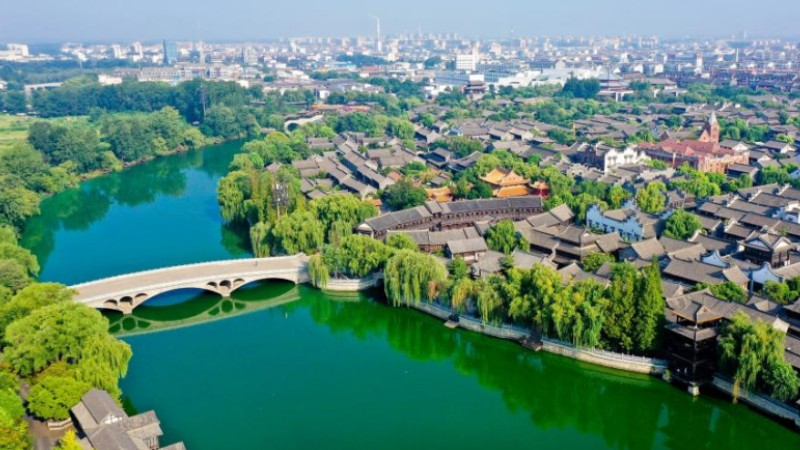China sees remarkable achievements in implementing forest chief scheme

Aerial photo taken on Aug. 22, 2021 shows the scenery of Saihanba forest farm in north China's Hebei Province. (Xinhua/Jin Haoyuan)
China recently honored typical regions for their significant achievements in implementing the country's forest chief scheme in 2022. Eight cities and counties were awarded by the State Council, and 23 cities and counties were commended by the National Forestry and Grassland Administration (NFGA).
In June 2022, China attained the goal of establishing the forest chief scheme as scheduled, which is aimed at building a long-term responsibility system featuring the joint responsibility of Communist Party of China committees and governments, localities where forests and grasslands are located being responsible for taking care of them, collaboration among different government departments, full coverage, and treatment at the source, said Liu Keyong, head of the forest resource management department under the NFGA.
Under the forest chief scheme, principal leaders of Party committees and governments at various levels are appointed as “general forest chiefs,” and China has nearly 1.2 million forest chiefs on various levels.
By promoting institutional building related to the forest chief scheme, the country has fostered a “safety net” to protect forests and grasslands.
The NFGA issued measures for the management of rural forest (grass) rangers to vigorously advance the standardization of forestry workstations and enhance the training and management of primary-level forestry workstations and forest rangers.
Thanks to the application of technologies such as satellite remote sensing and the internet, China has realized targeted and intelligent management of forests and grasslands, with data including the forest chief scheme's responsibility system, land greening, and resource protection being connected to the internet.
The NFGA has also built an evaluation and supervision system of the forest chief scheme on the national, provincial, municipal, county and township levels. Focusing on the protection and development of forest and grassland resources, the administration gives annual scores to forest chiefs based on their performance in such aspects as forest coverage and wetland protection rate.
Tang Xiangjun is the forest chief and Party branch secretary of a village in Bole city, Bortala Mongolian Autonomous Prefecture, northwest China’s Xinjiang Uygur Autonomous Region.
"Being a forest chief involves heavy responsibilities. I need to patrol the forests and be responsible for publicizing fire prevention, and the control of forest and grass diseases and pests, among others. I also need to immediately report any problems to a higher authority," Tang said.
The prefecture has adopted a management model that involves forest chiefs, management and protection stations, and forest rangers. It has built a prefecture-wide grid management system that covers the prefecture by dividing its resources, including forests, grasslands, green open space, wetlands, and deserts into a number of management grids, and designating forest rangers.
Gai Weiliang, an engineer with the prefecture's forest chief office, said since the launch of the forest chief scheme, the prefecture's forest coverage rate has increased to 9.62 percent from 9.5 percent, and the vegetation coverage ratio of grasslands to 43.62 percent from 43.03 percent. The prefecture has treated 266,500 mu (17,766 hectares) of desertified land annually, up from 164,300 mu, and put 53 percent of its wetlands under protection, up from 52 percent.
The typical regions have launched large-scale land greening programs, achieving ecological progress.
Yueyang county in Yueyang city, central China's Hunan Province, for instance, has implemented forest quality improvement, forest tendering and management, and an ecological corridor, among other projects, on 42,600 mu of land. Additionally, the county has finished the voluntary planting of 1.4 million trees and has built six city-level forest villages.
Chuzhou city in east China's Anhui Province planted 342,000 mu of forests in 2022, with the parkland per capita in urban areas reaching 19.31 square meters, ranking first in the province.
While promoting ecological progress, the typical regions have also driven the development of relevant industries, bringing wealth to residents.
Sanming city in southeast China's Fujian Province has included the high-quality development of its forestry industry in its annual major tasks for the forest chief scheme.
The city has vigorously developed forest-dependent industries such as herbal medicine and fungi, as well as locally-featured industries, including flowers, seedlings and camellia oleifera, helping expand the income for each household in these sectors by an average of more than 20,000 yuan.
Photos
Related Stories
- China's mangrove forests expand in coverage: minister
- Scenery of Arxan National Forest Park in north China's Inner Mongolia
- "King in the forest" revived through protection in NE China
- Achievements of China's green Great Wall---the Three-North Shelterbelt Forest Program
- Chinese vice premier stresses forest, grassland fire prevention
Copyright © 2023 People's Daily Online. All Rights Reserved.









